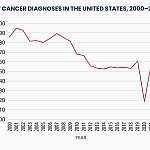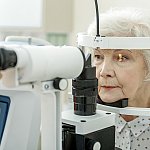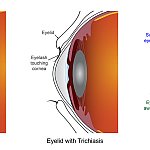
Researchers estimate that about 80 million people globally live with glaucoma — an eye condition affecting the
Glaucoma is known as “the silent thief of sight” because many times there are no symptoms in the earliest stage of the disease, making it hard to detect.
There are a number of risk factors for glaucoma, including
Now, a new study published in the British Journal of Ophthalmology says older adults with too much “good” HDL cholesterol may be at a higher risk of developing glaucoma.
Conversely, researchers found that people with higher levels of “bad” LDL cholesterol tended to have a lower risk of developing the eye condition.
For this study, researchers analyzed medical data from more than 400,000 participants between the ages of 40 to 69 in the U.K. Biobank Study.
Participants had the amount of fats in their blood measured, and their health was tracked for an average of 14 years.
Upon analysis, researchers found that study participants with higher amounts of HDL cholesterol in their blood had an increased risk of developing glaucoma.
Scientists reported that participants with the highest levels of HDL cholesterol were 10% more likely to develop glaucoma than those at the lowest levels.
On the other side, researchers discovered study participants with increased amounts of LDL cholesterol, total cholesterol, and triglycerides — a type of fat in the blood — were at a reduced risk for glaucoma.
Scientists found that participants with the highest levels of LDL cholesterol were 8% less likely to develop glaucoma than those with lower levels. That percentage rose to 14% less likely for those with the leading amounts of triglycerides.
The researchers did state that these observations continued among participants older than 55, and no significant association was noticed in those aged 40 to 55.
Medical News Today had the chance to speak with Alexander Solomon, MD, a neuro-ophthalmologist and strabismus surgeon of Pacific Neuroscience Institute at Providence Saint John’s Health Center in Santa Monica, CA, about this study and the importance of finding health concerns that may increase a person’s glaucoma risk.
“Glaucoma is the second most common cause of blindness, and unlike cataracts, which are the most common, it is irreversible,” Solomon explained. “Because all forms of glaucoma typically impact a patient’s peripheral vision first, a patient may have glaucoma for years before they are symptomatic.”
“Treatments for glaucoma are directed at slowing disease progression, so catching it and stopping it in its early stages before it becomes symptomatic is key,” Solomon continued.
“Knowing health concerns that could increase someone’s risk may help direct us to screening patients sooner or more frequently to catch them before the disease really affects their vision. Similarly better understanding risk factors for glaucoma may help us elucidate some of the more mysterious mechanisms of glaucoma, which can occur and progress seemingly independent of elevated intraocular pressure, which is its most classically associated risk factor.”
— Alexander Solomon, MD
Solomon also said that he would take the results of this study with quite a bit of caution because of their determination of the status of their two main associated factors—the definition of glaucoma and participants’ lipid levels, which were determined from a single non-fasting blood sample at the beginning of the study.
“The definition of glaucoma here is somewhat suspect, as it must be when you’re using a database rather than directly recruiting or interacting with patients,” Solomon explained. “It relies on self-reported data and hospital inpatient diagnoses — which may be heavily influenced by self-reporting, given glaucoma would rarely play a significant role in hospital treatment or care — but does not necessitate an ophthalmologist confirming the diagnosis of glaucoma, which would be invaluable.”
“(And) these lipid levels can vary by what was recently eaten from day to day, hence why fasting labs are more valuable, let alone long term with treatment or lifestyle changes,” he continued. “Simply categorizing people by a single non-fasting test feels like it misses the point of whether or not certain lipid levels increase risk for glaucoma, which is a disease that develops slowly over time in most cases.”
“As stated, this study poses an interesting possibility, but leaves many concerns unanswered. I’d like to see a more stringent study done that actually used ophthalmologists to help define specific glaucoma subtypes and severity and followed fasting lipid levels over time as this would be a much stronger correlation.”
— Alexander Solomon, MD
MNT also spoke with Yu-Ming Ni, MD, a board certified cardiologist and lipidologist at MemorialCare Heart and Vascular Institute at Orange Coast Medical Center in Fountain Valley, CA, about this study, who commented he was surprised by its findings.
“At first glance, higher lipids should be associated with worse outcomes overall, including higher rates of glaucoma,” Ni explained. “I would think that more good cholesterol (i.e. HDL-C) would be associated with lower rates of glaucoma, and more bad cholesterol (i.e. LDL-C) associated with higher rates of glaucoma. But this was not the case with this study and another large cross-sectional study mentioned in the introduction of the paper.”
“Given that the mechanism by which higher HDL may be associated with higher glaucoma risk is unknown, I suspect this finding may be confounded by other factors. It is also known that both too high and too low HDL-C are associated with higher rates of heart disease. In other words, there is such a thing as too much good cholesterol.”
— Yu-Ming Ni, MD
“Ultimately, the only way to determine if good cholesterol is truly associated with higher rates of glaucoma is to do a clinical trial,” Ni said.
“You can study a therapy that lowers HDL-C and assess if glaucoma rates are lower. I suspect this type of study will never be done because of the fear of higher rates of heart disease. But it would be wrong to assume that higher HDL would increase your risk of glaucoma without knowing the mechanism or understanding confounding risk factors. Therefore, I’m not making a big deal out of this study, and I will continue to council patients that the ideal HDL-C is about 50-60 for men and 60-70 for women,” he said.





